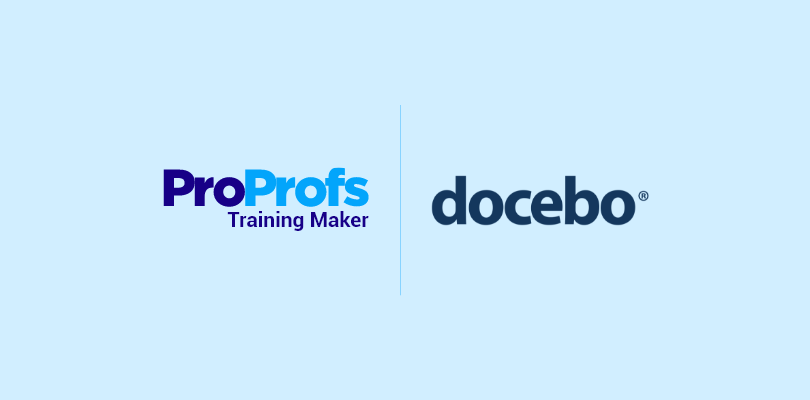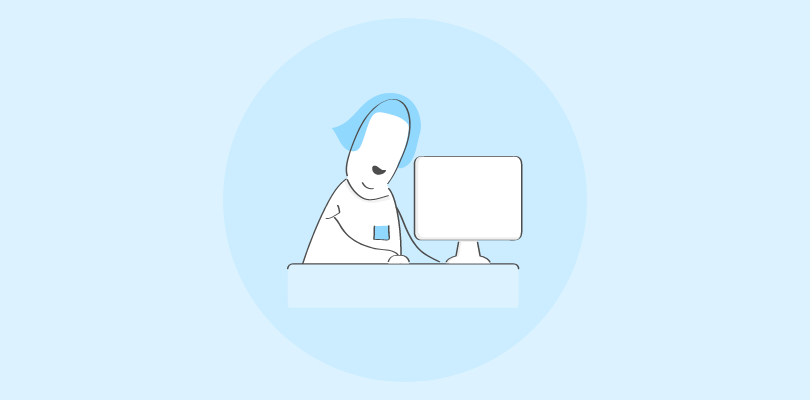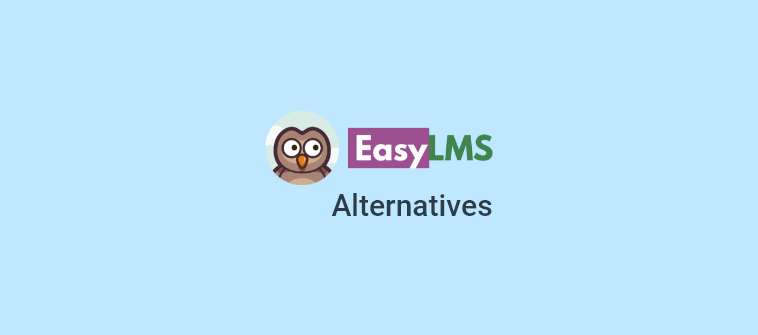Most training falls flat. There, I said it.
You open the LMS, click through some slides, guess a few quiz answers, and call it a day. No one remembers anything. No one cares.
LMS gamification is how you flip that. Not with cute badges or fake points, but with mechanics that actually make people want to finish, compete, and learn without zoning out halfway through.
I’ve tested these platforms inside real teams, the ones with tight deadlines, zero attention spans, and way too much on their plate. I know what breaks. I know what scales. And I know which gamified LMS platforms actually get results.
So I put this guide together to show you what good gamification actually looks like, features that matter, mistakes to avoid, and the best LMS gamification platforms that are genuinely worth your time.
If you’re done with low-effort training that no one finishes, you’re in the right place.
What Is LMS Gamification?
LMS gamification turns forgettable training into something people actually complete. It uses tools like points, badges, leaderboards, and timed challenges to keep learners engaged and moving forward.
You’ve seen it work before. Duolingo gets millions of people to practice grammar daily, not because grammar is fun, but because the app turns it into a game. Streaks. Sound effects. That threatening little owl. It’s absurd, and it works.
Now bring that logic into your LMS. Instead of clicking through a compliance module half-asleep, learners stay focused. They track progress. They compete. And most importantly, they remember what they’re doing.
Gamification in LMS isn’t a cover for weak content. It’s about structuring training in a way that holds attention, rewards progress, and actually gets results.
5 LMS Gamification Features That Actually Work
Gamification works when it changes behavior, not when it simply adds decoration. Below are the core elements that consistently boost engagement and results when used with intent.
1. Smarter Point Systems That Motivate Progress

Why Most Point Systems Fail:
Awarding the same 10 or 20 points for every action doesn’t motivate learners differently. It treats every action as equal, even when it’s not.
What Actually Works:
- Challenge-based points: Give more points for completing harder content, especially if a learner has previously struggled with it.
- Skill-weighted scoring: Prioritize critical business skills. For example, safety training might earn 100 points while soft skills like company trivia earn 10.
- Peer-approved bonuses: Let colleagues award bonus points for helpful answers, collaboration, or shared resources.
- Real-world application points: Award points when learners apply training on the job; managers can verify it.
2. Badge Systems That Reward Real Skill
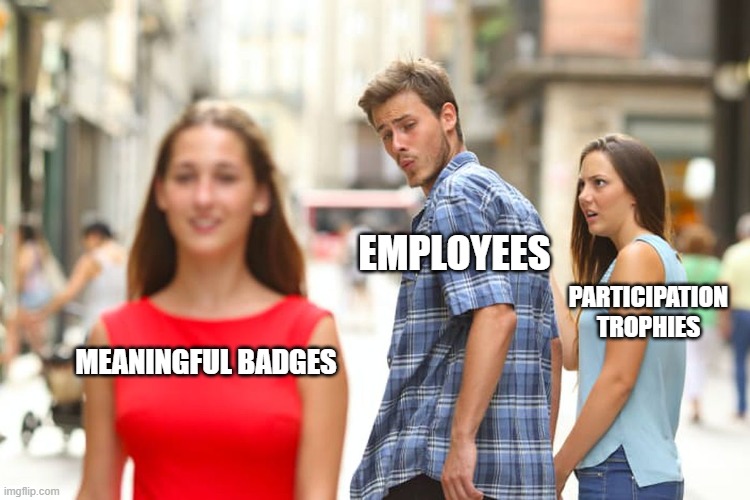
The Problem With Most Badges:
When everyone gets a badge for logging in or completing a module, badges lose value.
What Works Instead:
- Stackable badges: Combine related modules into a mastery badge, like “Advanced Customer Service” after 3 core topics.
- Nominated badges: Let teams award badges like “Knowledge Sharer” to peers.
- Time-bound achievements: Reward quick learners with “First Responder” badges for finishing urgent training fast.
- Tiered badges: Let users level up from Bronze to Gold based on expertise or consistency.
- Cross-functional badges: Encourage collaboration across teams with shared achievement badges.
3. Leaderboards That Encourage Without Stress
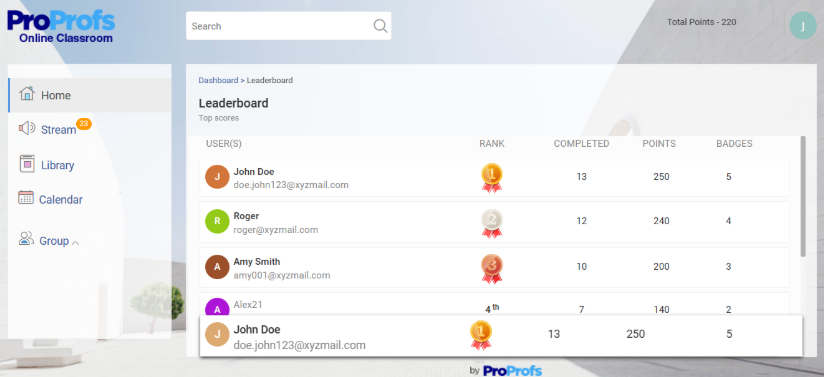
Why Classic Leaderboards Backfire:
Ranking individuals by total points often discourages late starters and stresses learners who aren’t naturally competitive.
What Works Better:
- Team-based rankings: Let departments or teams compete instead of individuals.
- Category-specific boards: Separate leaderboards for soft skills, compliance, and speed encourage wider participation.
- Progress-based scoring: Rank by how much someone improved, not how high they scored.
- Time-limited challenges: Weekly reset leaderboards keep things fresh and inclusive.
- Opt-in options: Allow learners to choose whether they want to participate.
Community Feedback:
Reddit users report that opt-in, progress-based challenges improve engagement, especially with older or introverted employees.
4. Visual Progress Tools That Show Real Growth
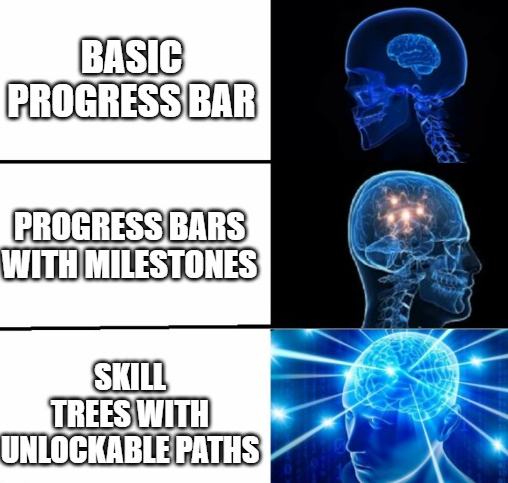
Plain progress bars don’t inspire. Learners need a clearer view of their growth and where it leads.
What to Use Instead:
- Skill trees: Let learners unlock topics in a logical sequence, revealing advanced modules as they go.
- Career maps: Show how current learning connects to job roles or future goals.
- Streak tracking: Track consecutive learning days (optional), like Duolingo, to build momentum.
- Heat maps: Let learners (and managers) see strengths and weak areas at a glance.
- Milestone moments: Celebrate big wins, like completing a learning path or passing a certification.
5. Social Learning Mechanics That Sustain Engagement

This is often overlooked. Yet peer interaction is one of the biggest predictors of sustained learning.
Ways to Make It Work:
- Mentorship rewards: Give points or badges when learners help others succeed.
- Forum leaderboards: Highlight those who share helpful posts or answers in discussion threads.
- Team-based missions: Set group challenges that require collaboration to complete.
- Public recognition: Feature “Learning Heroes” or “Top Contributors” monthly.
- Buddy system: Pair up learners to complete modules together or review each other’s progress.
10 Best LMS for Gamification
This list of corporate LMS with gamification features is the result of my experience, extensive research, and peer recommendations. I have also considered unbiased reviews from independent sources.
Now, before we get into the top 10 LMS gamification platforms, here’s a quick comparison table to see how they stack up.
| LMS Gamification Platform | Setup Complexity | Technical Expertise Required | Best For | Pricing | Rating |
|---|---|---|---|---|---|
| ProProfs Training Maker | Quick Start | None | Employee Training & LMS | Free plan for small teams, paid plan starts at $1.99 per active learner/month | 4.6 |
| Moodle | Quick Start | Minimal | Open Source Learning | Free, paid plans start at AUD 180/year | 4.1 |
| Absorb LMS | Quick Start | None | Complex Training Needs | Custom pricing | 4.6 |
| iSpring Learn | Moderate | Some | eLearning & Training | Starts at $2.29/user/month for 300 users | 4.6 |
| Tovuti LMS | Moderate | Some | Corporate Learning & Development | Custom pricing | 4.6 |
| Paradiso LMS | Moderate | Some | Skills Training | Custom pricing | 4.1 |
| LearnUpon | Complex | High | Delivering Impactful Training | Starts at $599/month | 4.6 |
| Litmos | Complex | High | Off-the-Shelf Training | Custom pricing | 4.3 |
| Docebo | Complex | High | Complex Enterprise Training | Custom pricing | 4.3 |
| EasyLMS | Complex | High | Fast, Easy Customer Training | Starts at $105/month | - |
1. ProProfs Training Maker – Best for Employee Training & LMS
ProProfs Training Maker makes gamified learning simple, scalable, and actually effective. It lets you create engaging online courses with built-in game elements like points, badges, leaderboards, flashcards, and branching quizzes, no design skills needed.
What makes it stand out is how seamlessly it combines ease of use with intelligence. ProProfs’ built-in AI generates quiz questions, personalizes content, and tracks performance in real time, so you’re not just adding gamification, you’re optimizing it as you go.
You can enhance training further with learning paths, brain games, and completion certificates to keep learners motivated through every stage. For collaborative learning, it offers virtual classrooms and discussion forums that make it easy for teams to stay connected.
Whether you’re delivering training on policies, skills, compliance, or product knowledge, ProProfs adapts to your goals. You can repurpose your existing content, PDFs, PPTs, videos, and launch gamified courses fast. It also integrates with tools like Zoom, Salesforce, Mailchimp, and BambooHR, so it fits right into your workflow.
What You’ll Like:
- Learners earn points for real progress, like mastering skills or completing key tasks, not just logging in
- Foster healthy competition with leaderboards that rank learners based on performance
- Reinforce learning and improve retention with interactive flashcards
- AI course creator and user management functionalities to simplify employee training
- You can upload PDF, PPT, DOC, videos, and images to create a course from your existing training materials.
- AI reporting for detailed, real-time insights on individual and group progress
- Awesome customer support team, you can always rely on
What You May Not Like:
- No downloadable or on-premise version
- Dark user interface option is not yet available
- No dedicated account manager for the free plan, unlike the paid plan
User Rating:
G2: 4.6/5
Capterra: 4.8/5
“It’s affordable and easy to use. A rare combination. We don’t have an in-house training department, so being able to create and assign courses quickly is a huge plus.” — Allegra P., Founder (G2)
Pricing:
Forever free plan for small teams. Paid plan starts at $1.99 per active learner/month for large teams. No hidden charges.
See how Global Linking Solutions (GLS) used LMS gamification with ProProfs to boost communication and streamline onboarding across teams.
Want to Motivate Your Learners?
Use gamification to drive engagement and better retention.
2. Moodle: Best for Open Source Learning
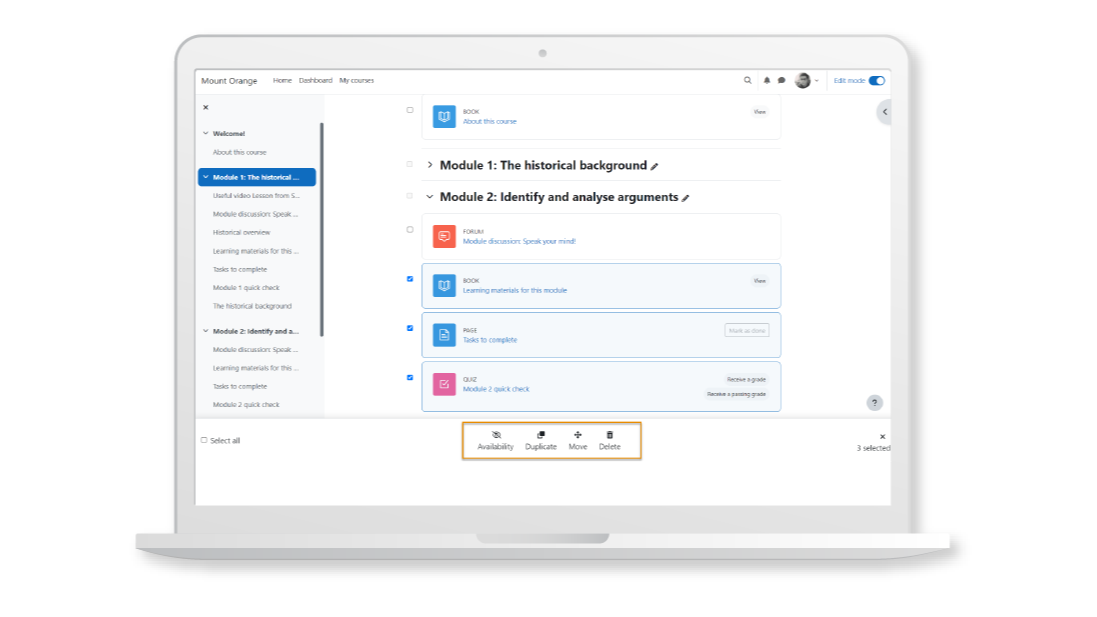
When it comes to creating a personalized learning experience, Moodle stands out. If you value flexibility and customization in your learning management system, Moodle lets you do just that. The best part? It’s open source, which means you can use it, tweak it, and even share your version with others. Whether you’re running a small training program or a large educational institution, Moodle adapts to your needs.
Moodle facilitates collaborative learning through various tools like forums, wikis, glossaries, and database activities. This gamified training platform has several gamification elements, such as points, levels, badges, leaderboards, and certificates.
Moodle has an active community that contributes significantly to its improvement by sharing plugins and integrations. Its Level Up plugin enables learners to gain experience points (XP) by completing activities or engaging with the course. Learners can also advance to higher levels and unlock new rewards, such as badges, avatars, or custom messages.
What You’ll Like:
- The platform is built on social constructivist pedagogy
- Numerous plugins such as Level Up XP, Game, Quizventure, Stash to enhance functionality and gamification
- LTI (Learning Tools Interoperability) standard support for seamless integration with other educational tools
- It is supported by a global community of developers, educators, and learners contributing to its continuous improvement.
What You May Not Like:
- Limited insights from the reporting feature may be a drawback for certain users.
- Course engagement tracking could offer more comprehensive details.
- Moodle’s scheduling management system could be improved to support organization and planning better.
User Rating:
G2: 4.1/5
Capterra: 4.3/5
“Moodle is one of the most flexible and feature-rich open-source Learning Management Systems available.” — Amey D., Business Solutions Specialist (G2)
Pricing:
Free (reporting is basic) and paid plans are available. Paid plans start at AUD 180/year.
3. Absorb LMS – Best for Complex Training Needs
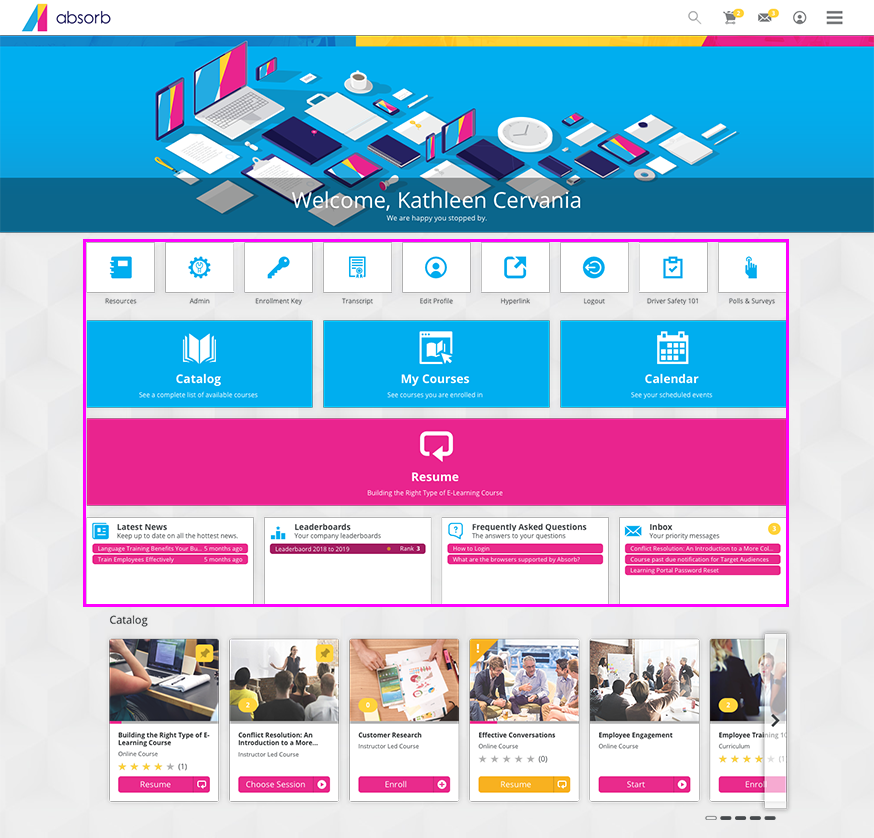
If you’re dealing with complex training needs, Absorb LMS is the tool that’s up to the challenge. Whether your team prefers virtual classrooms or personalized learning paths, Absorb adapts to different learning styles and content formats and makes it easier to engage everyone. The administration features simplify tasks like enrollment and tracking so you can focus on what matters most: delivering impactful training.
One of the features that impressed me about this LMS with gamification is its Intelligent Recommendations. It examines the learner’s profile, preferences, behavior, and feedback to suggest courses, videos, articles, and other resources. Another top feature, Intelligent Assist, allows you to perform admin tasks efficiently using natural language commands. It saves you time and hassle by automating common admin tasks.
Plus, with powerful analytics, you’ll always know how to improve. Need it to work with your existing systems? No problem. Absorb integrates smoothly and makes data management a breeze.
What You’ll Like:
- Introduce timed challenges that encourage quick thinking and decision-making
- Create captivating storylines that guide learners through their training journey
- Integrate mini-games related to the training content to make learning more fun
- Enable group challenges where learners can team up and collaborate
What You May Not Like:
- Users must undergo re-enrollment following each course modification
- The setup and configuration might entail a certain level of complexity
- Scheduling recurring sessions is not feasible
User Rating:
G2: 4.6/5
Capterra: 4.5/5
“Creating content is incredibly easy—it’s as intuitive as building a slide deck. The learner experience is thoughtfully designed, making it engaging and effective.” — Stacey G., VP (G2)
Pricing:
Custom pricing
4. iSpring Learn – Best for eLearning & Training

With iSpring Learn, you get a robust LMS that makes onboarding, upskilling, and certifying your team easy. Its standout feature is the ability for employees to access training from any device, even without an internet connection. Whether in between meetings or traveling, learning continues smoothly.
The platform helps increase learning retention by turning mandatory training into an enjoyable experience. iSpring Learn also promotes skill development through competitive exercises and rewards. The gamified approach speeds up change adoption, empowering employees to apply knowledge quickly.
iSpring Learn really stands out with its ability to turn PowerPoint slides into interactive HTML5 courses in just one click. You don’t need to worry about losing any animations or effects—it all stays intact. That means you can create fantastic courses without any coding or design skills. But it doesn’t stop there. iSpring also helps build a social learning environment where your team can stay connected through news feeds, chats, and feedback.
What You’ll Like:
- Provide digital badges to learners for achieving milestones
- Customize award titles for every skill or role
- Assign homework and tasks for learners to complete
- Effortless PPT to HTML5 conversion for creating engaging training content using existing learning materials
What You May Not Like:
- Challenges in training culturally diverse teams due to limited language support
- Steep learning curve for mastering LMS functionalities and settings
- Lack of built-in course marketplace or content library
User Rating:
G2: 4.6/5
Capterra: 4.7/5
“I like how I can take an already created power point orientation packet and create something both interactive and fun for learners.” — Cindy H., Safety Manager (G2)
Pricing:
Starts at $2.29/user/month. For 300 users.
5. Tovuti LMS – Best for Corporate Learning & Development
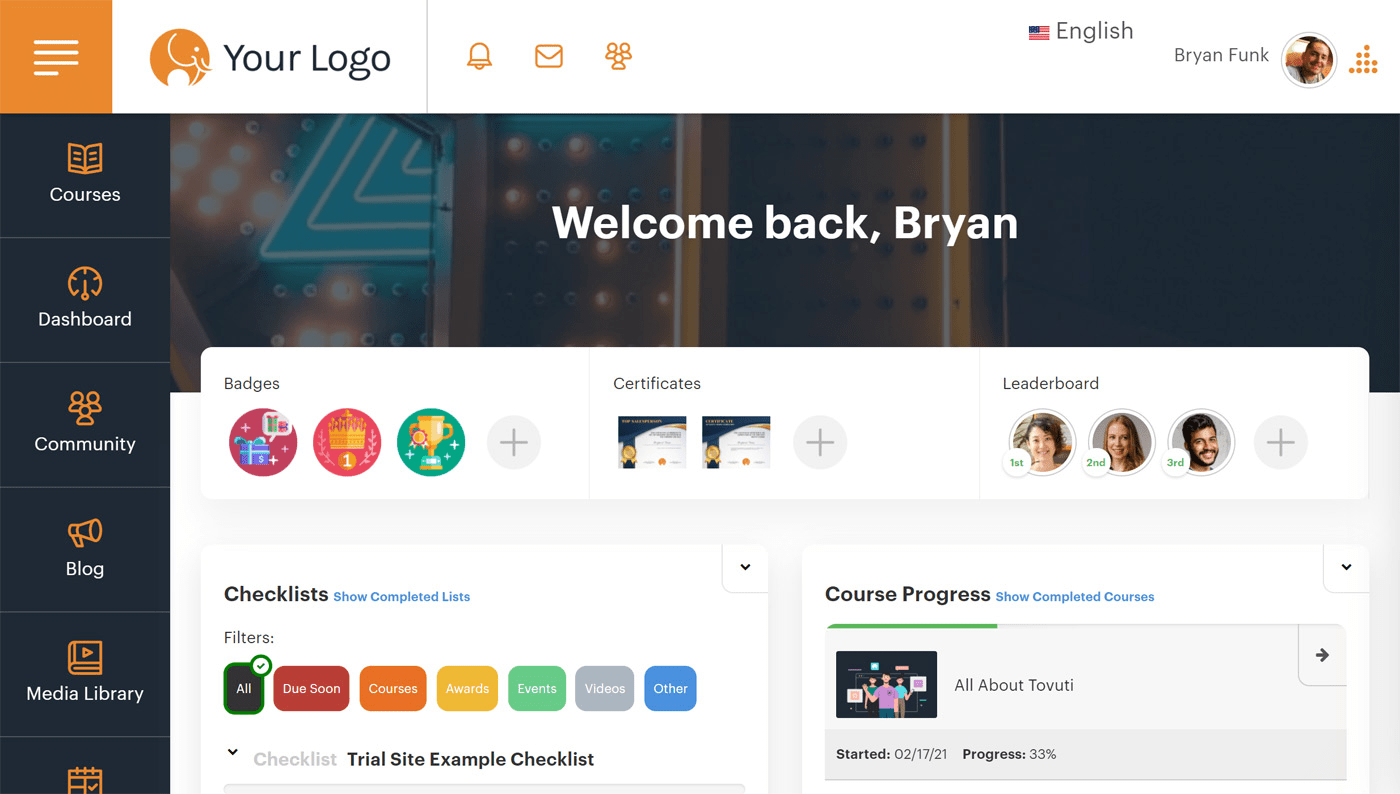
Tovuti LMS brings a fresh approach to corporate training by making learning interactive and fun. It’s designed to engage employees through multimedia content, quizzes, and assessments, all crafted to challenge and motivate. And if your team loves a bit of healthy competition, Tovuti’s gamified features like points, badges, and leaderboards will keep them hooked. They can even unlock rewards like discounts and certificates with their points!
Tovuti is also a powerhouse for live training sessions. Whether using Zoom, GoToMeeting, or Skype, this gamified LMS easily supports video conferencing. It’s easy to host virtual events, webinars, and breakout rooms with live chat, polls, and Q&A. You can also record these sessions for future reference.
Tovuti also excels at creating a collaborative environment. Employees can join groups, comment on courses, and share their achievements to promote knowledge-sharing across the team.
What You’ll Like:
- Set challenges to encourage learners to complete tasks within a given timeframe
- Includes virtual tours and audio recording tasks to boost engagement
- Microlearning support for enhanced knowledge retention
What You May Not Like:
- The learning curve is steep, requiring time to understand all features.
- There is no dedicated Windows app; it must be accessed via a web browser.
- There are limited customization templates for site appearance.
User Rating:
G2: 4.6/5
Capterra: 4.8/5
“I have been using Tovuti since the beginning of 2022 and first off, they have been an awesome partner from beginning to end.” — Jerry H., Training Supervisor
Pricing:
Custom pricing
6. Paradiso LMS – Best for Skills Training

Paradiso LMS is a versatile, innovative, and highly scalable solution that can help you deliver a memorable learning experience for employee upskilling. It lets you create engaging and effective learning programs with game elements, analytics, integrations, and more.
With this gamified LMS, you can motivate your learners to achieve their learning goals by using badges, points, leaderboards, levels, feedback, certificates, and rewards. You can also let your learners create their own avatars and personalize their learning environment. Moreover, you can enhance your courses with AI-powered videos that include quizzes, polls, and surveys. Generate captions, transcripts, and translations for your videos with the AI Media Studio feature.
Paradiso LMS lets you create multiple sub-domains within your LMS, each with its own branding, theme, courses, and users. This multi-tenant feature is ideal for training different audiences, such as employees, customers, and partners.
What You’ll Like:
- Paradiso LMS offers various features and functionalities, such as gamification, performance management, reporting, integration, customization, and accessibility.
- Learners can take courses anytime, anywhere, and on any device.
- Provides excellent customer support; you can contact them through chat, email, or phone and get quick and helpful responses.
- Create multiple tenants, white-label your LMS, and integrate with various platforms such as Salesforce, Moodle, Zoom, and more.
What You May Not Like:
- The user interface could be improved. Some users have reported that it is slow, outdated, or unattractive.
- Its updates are not frequent or consistent; some users have experienced glitches after updating their LMS.
- It would have been great if there was an HR platform along with this as it takes around 3-4 hours to get a hang of this platform
User Rating:
G2: 4.1/5
Capterra: 4.2/5
“Paradiso LMS contains many attractive features as well as content that can jumpstart the user’s course offerings.” — Claudia C., Docente (G2)
Pricing:
Custom pricing
7. LearnUpon – Best for Delivering Impactful Training
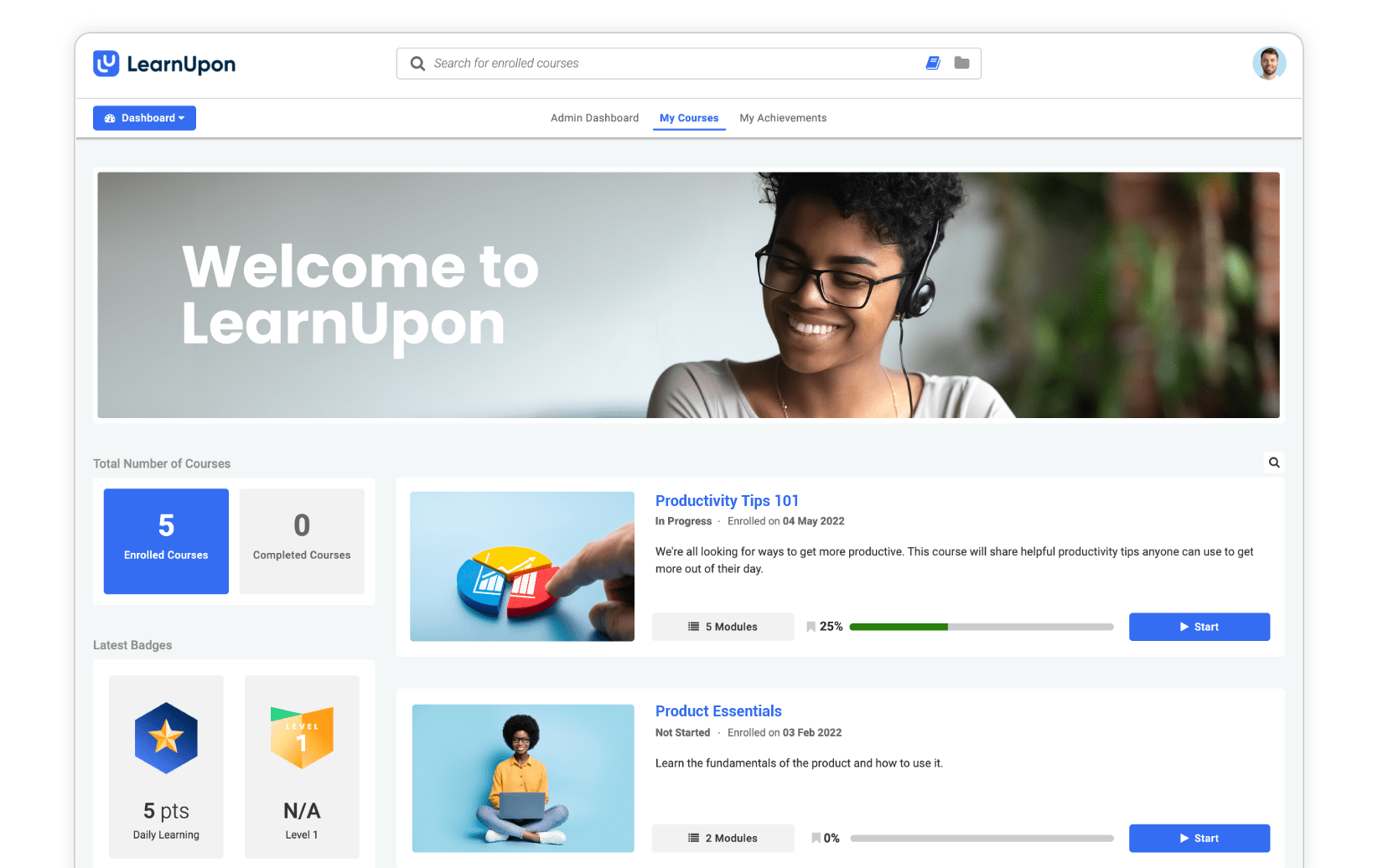
Ever feel like your training programs just don’t hit the mark? You’re not alone! Many organizations struggle to engage their learners and make training stick. This is where LearnUpon steps in as a game-changer for delivering impactful training. Whether onboarding new hires, enhancing skills, or ensuring compliance, LearnUpon can easily tackle your varied training needs. Plus, the automated enrollment process means no more drowning in paperwork or frantic email exchanges, so admin stress is gone!
What makes LearnUpon shine is its gamification features. It has levels, badges, and points that turn training into a fun competition! You can assign different point values to activities and courses and customize those gamification elements to suit your learning goals.
Want to design unique badges that fit your company culture? Go for it! Curious about how your team ranks? Leaderboards keep the excitement alive. Plus, with gamification reports, admins can monitor how these features boost learner engagement and performance. It’s like having a backstage pass to the training show!
What You’ll Like:
- Implement up to 5 levels to mark learners’ progress and achievements
- Issue digital certificates for completing courses or reaching certain milestones
- Integrate with various third-party tools, including Google Analytics, Salesforce, and Zapier.
- Access round-the-clock live chat, phone, email support, and online help guides and webinars.
What You May Not Like:
- Creating course modules demands substantial effort.
- Once a course or test is updated, retaking it is not an option.
- LearnUpon might not be suitable for users seeking highly advanced features.
User Rating:
G2: 4.6/5
Capterra: 4.8/5
“Extremely positive experience for users, admins and customers.” — Siobhan W. (G2)
Pricing:
Starts at $599/month
8. Litmos – Best for Off-the-Shelf Training
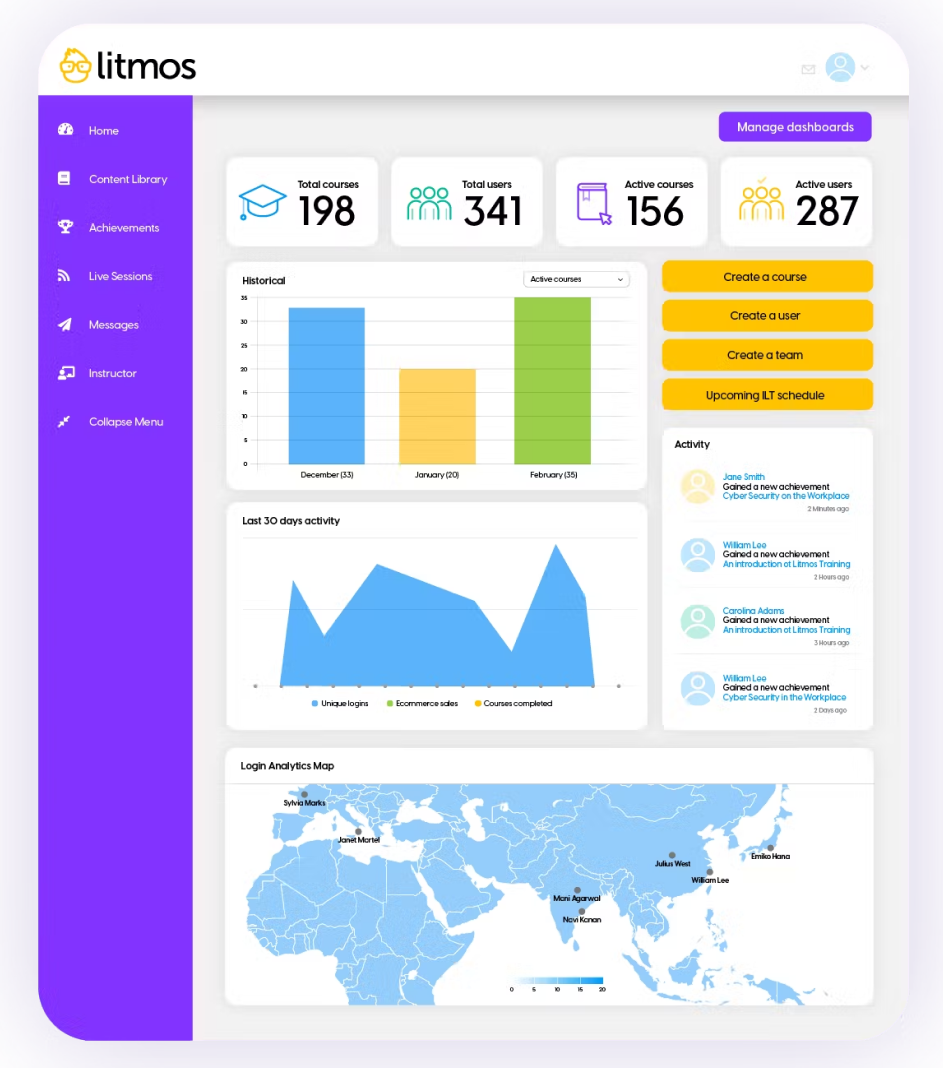
Tired of spending hours creating training content from scratch? Litmos has you covered with a library of over 80,000 pre-built courses. Whether you need compliance training, leadership development, or safety programs, Litmos helps you roll out training quickly and efficiently. And let’s be honest: who wouldn’t want to skip the hassle of starting from zero?
What’s cool about Litmos gamified LMS is its flexibility. It supports blended learning, so whether your team is remote or in the office, you can connect them with interactive virtual classrooms and webinars. You can mix online, offline, and live sessions into hybrid courses.
Gamification is where Litmos kicks into gear. Learners can earn points and badges, compete with peers, and progress through different levels. Plus, the mobile app lets learners access courses offline so that training can happen anytime, anywhere.
What You’ll Like:
- Progress through different levels as learners complete tasks and modules
- Organize challenges and competitions with specific goals
- Earn points for completing courses and participating in activities
- Integration with popular HR and performance management systems for centralized data management and reporting
What You May Not Like:
- The reporting system for learning paths should be more user-friendly and intuitive
- There’s a limitation in making courses optional for learners
- New users might encounter a learning curve when initially using the LMS
User Rating:
G2: 4.3/5
Capterra: 4.2/5
“We chose SAP Litmos for its’ ease of use and ability to build with us as we grow.” — Mary Anne P., L&D (G2)
Pricing:
Custom pricing
9. Docebo – Best for Complex Enterprise Training

If you have a large company, you might want to consider Docebo as your gamification training software. Docebo is also ideal for blended learning, as it offers webinars, face-to-face sessions, online courses, micro-learning, and gamified learning. Gamification elements include badges, points, leaderboards, contests, and rewards. Learners can earn points and badges for completing a course, passing a quiz, or participating in the social learning community. Points can be exchanged for rewards, such as certificates, vouchers, or access to premium content.
The tool can accommodate many users, integrate with various platforms, and support multiple languages. You can also tailor it to suit your audience’s needs.
Moreover, you can leverage its AI capabilities to train your employees according to your business objectives. The AI analyzes your learning content, identifies the skills it covers, and then matches it to your employees. This way, their learning paths adapt to their progress and your business changes.
What You’ll Like:
- Set up a rewards marketplace where learners can exchange points (converted into coins)
- Modern and user-friendly interface for easy course creation, management, and delivery
- Integrations with multiple tools, including third-party gamification platforms, such as Badgeville and Bunchball
- Encourage social learning by allowing learners to share achievements, badges, and progress on their profiles
What You May Not Like:
- Training videos are constrained by a size limit
- The API’s scope is limited and doesn’t provide access to all LMS objects and actions
- The pricing plans might not be flexible enough for small and medium-sized enterprises
User Rating:
G2: 4.3/5
Capterra: 4.4/5
“Docebo provides a highly customizable platform that allows us to tailor the learning experience to reflect our company’s branding and voice.” — Avery G., Learning Technology Specialist (G2)
Pricing:
Custom pricing
10. EasyLMS: Best for Customer Training
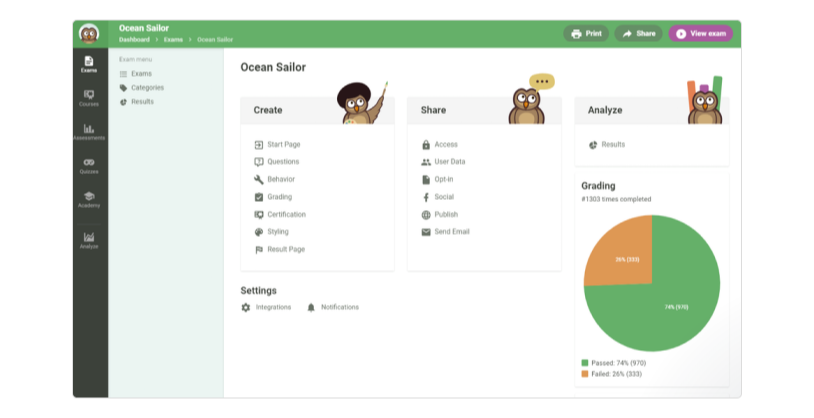
If you’re looking for a way to boost your customer service training without overcomplicating things, Easy LMS might just be your new best friend. The platform adjusts challenges to match your skill level, so it feels just right—neither easy nor hard. Plus, it adds a touch of storytelling, tying learning activities to exciting goals. Whether completing a quiz or unlocking rewards, Easy LMS keeps things interesting and engaging. It’s a fresh way to learn while having fun! Plus, adding gamification like leaderboards and badges ensures they stay motivated and on track.
For customer service teams, Easy LMS is perfect for crafting courses that teach employees how to handle tough situations and ultimately keep their customers happy. You can create learning paths that guide your team, from basic customer service skills to mastering your product’s most complex features. The best part? You can analyze their progress in real-time and provide immediate feedback to ensure everyone’s performing at their best. Integrating it with your CRM makes training even smoother, as there’s no need to juggle multiple platforms.
What You’ll Like:
- Flexible quiz and assessment options to adapt to various learning goals
- Features like public profile pages allow users to showcase their badges, skills, etc.
- Users can earn points and badges by sharing knowledge and helping others within the platform
- You can share reports from Easy LMS to other tools using webhooks
What You May Not Like:
- The interface appears somewhat outdated.
- The company should provide improved documentation for newcomers.
- It lacks a display of PPT or PDF files.
User Rating:
G2: –
Capterra: –
Pricing:
Starts at $105/month. Custom branding. Basic certification.
How I Evaluated These Tools
I didn’t choose these platforms just because they had gamification on their features page. I picked tools that are actually useful for teams that want to keep people interested and improve training.
Here’s what I looked for:
- Built-in gamification that works – Points, badges, leaderboards, progress tracking, these features had to be part of the main product, not hidden or complicated to set up.
- Real user feedback – I checked reviews on G2 to see what people liked, what they didn’t, and how these tools performed in real situations.
- Ease of use – I preferred tools that are easy to set up and manage without needing a tech expert. If a tool is too confusing, no one will use it.
- Training flexibility – Good platforms let you create different types of content, build challenges, and guide learners through a path, not just dump all materials in one place.
- Support and help when needed – Whether you’re a small team or running training for a large company, quick and helpful support can save a lot of time.
- Price and long-term value – I looked for fair pricing with features that justify the cost. Some tools offer good basics for small teams, while others scale well as you grow.
- Integrations that make life easier – I made sure the tools worked well with other software like HR systems, CRMs, or Single Sign-On, so it all connects without more manual work.
This mix of research, real feedback, and firsthand experience helped me pick platforms that don’t just look good, but actually help you build better training with gamification.
Get Free LMS Software — All Features, Forever.
We've helped 567 companies train 200,000+ employees. Create courses in under a minute with our AI LMS or use 200+ ready-made courses on compliance, harassment, DEI, onboarding, and more!
5 Gamification Challenges & How Users Actually Solve Them
I’ve spent time in communities, forums, and Reddit threads where users share real struggles with gamification in LMS platforms. While it can boost engagement, it’s not always smooth. Here are five common challenges teams run into and how they actually fix them.
Challenge #1: “This Feels Patronizing and Childish”
Why It Happens:
- Cartoon graphics and sound effects in professional training
- Badges for trivial activities (logging in, clicking next)
- Overly enthusiastic language that doesn’t match company culture
How Successful Companies Fix It:
- Professional Visual Design: Clean, modern interfaces without cartoon elements
- Meaningful Achievements: Badges tied to real skill development and business impact
- Cultural Alignment: Competitive gamification for sales teams, collaborative mechanics for R&D teams
- Employee Input: Survey teams about preferred recognition styles before implementing
Challenge #2: “Takes Too Much Time and Resources to Implement”
Reality Check on Implementation Time:
- Basic Gamification Setup: 2-4 weeks (industry average)
- Custom Badge Creation: 2-4 hours per badge type
- Integration with Existing Systems: 3-8 weeks depending on complexity
- User Training and Adoption: 4-8 weeks
Resource-Saving Strategies:
- Start with Platform Templates: Most LMS platforms provide pre-built gamification schemes
- Phased Implementation: Begin with points and badges, add advanced features later
- User-Generated Content: Let employees suggest and vote on badge ideas
- Partner with Vendors: Many platforms offer implementation support
Community Insight: Teams that rush full gamification implementation have 60% higher failure rates than those who start simple and iterate.
Challenge #3: “Doesn’t Work for Serious Topics Like Compliance”
The Misconception: Gamification means making everything “fun” and competitive.
What Actually Works for Serious Training:
- Progress Recognition: Certificates and milestone acknowledgments instead of competitive elements
- Scenario-Based Challenges: Real-world situation simulations with immediate feedback
- Knowledge Application Tracking: Points for correctly applying safety procedures on the job
- Peer Learning Networks: Recognition for employees who help others understand critical concepts
Challenge #4: “Creates Unhealthy Competition and Workplace Tension”
Warning Signs:
- Individual leaderboards causing anxiety and resentment
- High performers dominating all recognition
- Employees gaming the system instead of learning
- Exclusion of less tech-savvy workers
Alternative Approaches That Work:
- Collaborative Goals: Teams work together toward shared achievements
- Multiple Intelligence Recognition: Different leaderboards for different types of contributions
- Improvement-Based Scoring: Recognize progress, not just absolute performance
- Regular Reset Periods: Monthly or quarterly fresh starts
- Opt-In Participation: Respect employees who prefer private learning
Research Finding: Companies using collaborative gamification report 85% positive reception vs. 45% for competitive-only approaches.
Challenge #5: “Shallow Implementation That Doesn’t Drive Real Learning”
Symptoms of Poor Gamification:
- Points awarded for time spent, not comprehension
- Badges that don’t correlate with job performance
- No connection between gamified activities and business outcomes
- Focus on engagement metrics instead of learning results
Deep Implementation Strategies:
- Competency-Based Rewards: Tie gamification to measurable skill improvements
- Manager Integration: Supervisors confirm that gamified learning translates to job performance
- Long-Term Tracking: Monitor if gamified learners perform better 6+ months later
- Iterative Improvement: Regular surveys and adjustments based on user feedback
Trends and Tips to Keep Gamification Working
- Avoid short-term thinking: Many LMS gamification strategies fail because they chase quick engagement instead of building habits or improving performance over time.
- Use AI to adapt in real time: Modern LMS platforms are starting to personalize game mechanics, like scoring and challenge levels, based on individual learning progress and engagement patterns.
- Spot disengagement before it’s too late: Predictive systems can identify at-risk learners and automatically trigger re-engagement tactics such as reminders, easier entry points, or targeted content.
- Add real-world value to achievements: Gamified elements like badges and certifications are evolving into verifiable, career-relevant credentials that hold weight outside the platform.
- Make learning hands-on where it matters: VR-based training simulations are gaining traction, especially in healthcare, manufacturing, and safety training, where experiential learning is critical.
- Build for scale and change: Your gamification tools should integrate easily with HR systems, CRMs, and other software, while remaining flexible enough to evolve with your training goals.
- Track what actually works: Analytics and reporting features aren’t nice-to-haves—they’re essential for measuring whether your gamification efforts lead to real progress, not just activity.
Level Up Your Training With the Best LMS Gamification Platforms
LMS gamification isn’t just about making training fun, it’s about making it effective. When learners know where they’re going, why it matters, and how they’re progressing, they stay engaged. That’s what the right platform should deliver.
ProProfs Training Maker stands out for teams that want practical gamification with less setup. From badges and leaderboards to AI-backed insights, it helps turn everyday training into something people actually complete.
Whether you’re refreshing your current system or choosing one for the first time, use this list to filter what matters.
Training works when people care enough to finish it. LMS gamification is how you get there.
Frequently Asked Questions
How do I know if gamification will work with my company culture?
Start by surveying your employees about their preferred recognition styles. A corporate LMS with gamification features should match your culture, competitive teams often respond well to leaderboards, while collaborative teams benefit more from shared goals and peer recognition. For conservative industries, focus on professional achievement tracking over game-like elements.
What are some examples of gamification in education and corporate training?
In education, teachers use badges and points to reward participation or fast quiz responses. In the workplace, gamification in LMS platforms can include performance-based points, team-based challenges, and milestone rewards tied to learning goals. Both aim to make training more interactive and less of a checklist.
Should we gamify all our training or just certain types?
Not everything needs gamification. Focus on areas where engagement is low, such as compliance, onboarding, and skill-building programs, that tend to benefit most from LMS gamification. Sensitive topics should be handled carefully, even when using game mechanics, to maintain respect and relevance.


 We'd love your feedback!
We'd love your feedback! Thanks for your feedback!
Thanks for your feedback!





